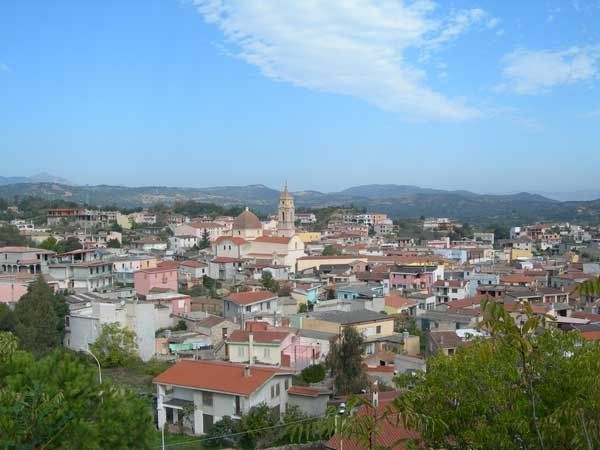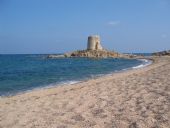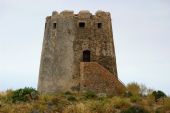
Barisardo (Bari sardo)
on the coast of Ogliastra
Bari called up to the Kingdom of Italy, is born as a union of ancient villages sprung up around the rural churches of Sant'Antine, San Leonardo, Santa Cecilia and Santa Susanna, which still identify the four main districts.
Its location (located about 4 km from the sea) was dictated by the need to avoid frequent vandal raids, protection of which was also erected by decree of the King of Spain, around the seventeenth century, the Tower, built conical submitted after restoration.
Nestling in the hills of Su Pranu, Pitzu and Monti, and the plateau of Teccu the country is well-climatic situation and a landscape characterized by centuries-old olive trees, almond trees and Mediterranean bush. They survive in the territory bariese several domus de janas and many nuraghi, some of which are in good condition.
The coastline, which stretches for about 10 km along the central eastern coast of Sardinia, starts from the town of Cea, bordering the territory of Tortolì, continue with the area Teccu, formed by promontories of basaltic rocks produced by the eruption of an ancient volcano, whose mouth is on the plateau.
The coast, which also offers beautiful reefs for fans of the seabed, so it opens on the lunghssimi ribbons of sandy beach, held together by the small rock on which stands the tower of Barisardo (Turri). Shady pine forests interspersed with large areas of Mediterranean and avenues of eucalyptus bordering the beaches up to the wetlands of Baunei and Tramalitzia, rich in flora and fauna of natural interest, bordering the coast of Cardedu.
In the village there are interesting historical and artistic artifacts in the ruins of the church of San Leonardo, remnant of the ancient villages.
Of particular interest is the church of the Patron, dating from the seventeenth and eighteenth centuries, in its precious polychrome marble balustrades staircases finely carved. The bell tower in baroque style dominates with its grandeur throughout the country.
On the left side of the parish church is interesting Oratory of the Confraternity of the Rosary, dating from the seventeenth century, to be restored.
The cuisine is based on simple but tasty dishes, traditional farming and pastoral, by Culurgionis (potato ravioli and cheese) to Malloreddus; bread holds a strong significance in the local history and there are different types, from the most elaborate bread pintau, to pistoccu and moddissosu, to know coccoi, a cake with pumpkin.
Excellent cheeses, from classic to pecorino su Casu ageru whose production is becoming increasingly important in the economy of the country.
Excellent roasts on a spit and red and white wines, a family production, mainly from grapes Cannonau and Monica.
Its location (located about 4 km from the sea) was dictated by the need to avoid frequent vandal raids, protection of which was also erected by decree of the King of Spain, around the seventeenth century, the Tower, built conical submitted after restoration.
Nestling in the hills of Su Pranu, Pitzu and Monti, and the plateau of Teccu the country is well-climatic situation and a landscape characterized by centuries-old olive trees, almond trees and Mediterranean bush. They survive in the territory bariese several domus de janas and many nuraghi, some of which are in good condition.
The coastline, which stretches for about 10 km along the central eastern coast of Sardinia, starts from the town of Cea, bordering the territory of Tortolì, continue with the area Teccu, formed by promontories of basaltic rocks produced by the eruption of an ancient volcano, whose mouth is on the plateau.
The coast, which also offers beautiful reefs for fans of the seabed, so it opens on the lunghssimi ribbons of sandy beach, held together by the small rock on which stands the tower of Barisardo (Turri). Shady pine forests interspersed with large areas of Mediterranean and avenues of eucalyptus bordering the beaches up to the wetlands of Baunei and Tramalitzia, rich in flora and fauna of natural interest, bordering the coast of Cardedu.
In the village there are interesting historical and artistic artifacts in the ruins of the church of San Leonardo, remnant of the ancient villages.
Of particular interest is the church of the Patron, dating from the seventeenth and eighteenth centuries, in its precious polychrome marble balustrades staircases finely carved. The bell tower in baroque style dominates with its grandeur throughout the country.
On the left side of the parish church is interesting Oratory of the Confraternity of the Rosary, dating from the seventeenth century, to be restored.
The cuisine is based on simple but tasty dishes, traditional farming and pastoral, by Culurgionis (potato ravioli and cheese) to Malloreddus; bread holds a strong significance in the local history and there are different types, from the most elaborate bread pintau, to pistoccu and moddissosu, to know coccoi, a cake with pumpkin.
Excellent cheeses, from classic to pecorino su Casu ageru whose production is becoming increasingly important in the economy of the country.
Excellent roasts on a spit and red and white wines, a family production, mainly from grapes Cannonau and Monica.
-
Search
-
Categories
- APP FAITA Sardegna
- HOLIDAY PACKAGES
- CAMPING VILLAGE Sardinia
- Where to eat
- TRANSPORT Sardinia
- BEACHES in Sardinia
- Tours in Sardinia
- KITCHEN traditional Sardinian
- WINES Sardinia
- SPIRITS of Sardinia
- EVENTS in Sardinia
- CORTES Apertas in Sardinia
- SPORT in Sardinia
- MAP Sardinia
- PHOTOS Sardinia
- VIDEO Sardinia
- Useful Numbers Sardinia
- DOGGIE BEACH in Sardinia
- Contact information
- archivio
-
Topics
- Camping e Village Sardinia
- Tourism in Sardinia
- resorts in Sardinia
- Sardinian beaches routes
- Specialties at the table
- South Coast Cagliari
- Costa Rei itinerari
- Ogliastra itinerari
- Nuoro e provincia itinerari
- Gallura itinerari
- Sassari e provincia itinerari
- Oristano e provincia itinerari
- Autunno in Barbagia 2013
- Aerei per la Sardegna
- Traghetti per la Sardegna
- Storia di Sardegna
- Feste e sagre della Sardegna
- Camping Village e Spiagge dog friendly
- Spiagge accessibili con l'amico cane












